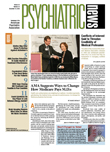Scientists are still a long way from determining whether people's“ voluntary” actions are governed by “free will” or predetermined by brain chemistry. But at least they've reached the point where they have unmasked some of the brain areas that subserve such actions.
So said Patrick Haggard, Ph.D., of University College London, England, and Brian Knutson, Ph.D., of Stanford University—both cognitive neuroscientists—at a session on “Willpower: What Really Governs Our Choices?”
The session was part of a mini-convention titled “Frontiers in Addiction Research,” sponsored by the National Institute on Drug Abuse (NIDA) in Washington, D.C., in November, just prior to the annual meeting of the Society for Neuroscience.
The cognition preceding a person's voluntary actions can be divided into phases, Haggard and Knutson explained to an audience largely made up of young neuroscientists. There is the anticipation phase, and there is the actual decision to act or not act phase.
As far as the anticipation phase is concerned, both the nucleus accumbens and the caudate areas of the brain appear to be major players, Knutson said. For example, he and his colleagues found that when subjects anticipated enjoying erotic pictures, their mental state coincided with an increased activation of the nucleus accumbens. In contrast, when subjects anticipated punishment, their mental state coincided with a turning on of the caudate.
Thanks to functional magnetic resonance imaging, which has been available since the mid-1990s, scientists can visualize changes in the brain activity of individuals only seconds before their anticipations lead to an actual decision to act or not act, Knutson continued.
He and his coworkers have found that nucleus accumbens activation precedes, for example, the purchase of a desirable product or the decision to take a risk, whereas activation of the prune-size insula area of the brain and the deactivation of the mesial prefrontal cortex precedes, say, the rejection of overpriced products or the decision to not take a risk.
Now, imagine that you are angry at your boss and are about to send him or her a nasty e-mail, but decide at the last second not to click on the“ send” button.
“Your dorsal-medial frontal cortex has undoubtedly kicked in,” Haggard said. He further explained that he and a colleague found that a specific area of the dorsal-medial frontal cortex is robustly switched on when people prepare to act, but then decide not to.
Even though the brain activity leading up to people's actions can now be studied scientifically, “we clearly need to move on to more naturalistic and long-term studies,” Haggard asserted.
Added Knutson: “We hope to get to the point where we have a model of how the brain makes decisions and to find out whether people who are addicted make decisions in the same way that nonaddicted persons do.”
Meanwhile, Nora Volkow, M.D., director of NIDA, reported not long ago that certain areas of the brain are already known to be compromised by drug addiction. They are the anterior cingulate gyrus, which governs attention and regulation of impulsivity; the orbital prefrontal cortex, which mediates the assignment of value to environmental stimuli; and the dorsal lateral prefrontal cortex, a major neural substrate of executive function and decision making (Psychiatric News, July 6, 2007). ▪
